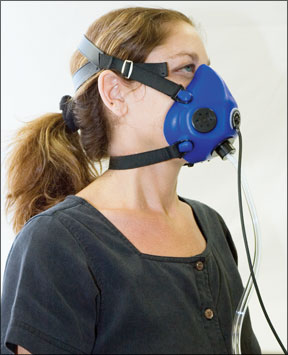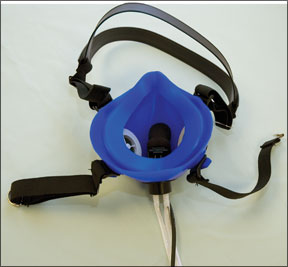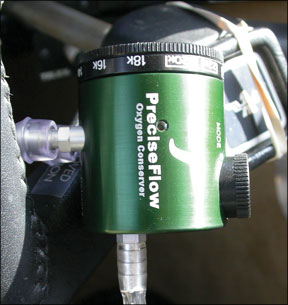Not so long

monitoring devices, all at competitive prices. In fact, since we last reviewed oxygen equipment in our August 2001 issue, the industry has almost reinvented itself, due in part to advances in the medical market.
If your portable system dates back to the days when loran was the hot choice for navigation, there’s no need to spring for a complete new system to benefit from the latest stuff. After all, a cylinder is a cylinder. Instead, upgrading some basic components may be the way to go. We asked Aeromedix.com, Mountain High and Precise Flight for examples of their latest oxygen gear, then we plugged and unplugged hoses, donned masks and played with high-tech regulators. In the process, we found some good reasons to upgrade.
Regulators
Once oxygen is in a portable cylinder at something like 2000 PSI, you need some means to reduce the pressure to breathable limits. Regulators perform this function by stepping down the high cylinder pressures closer to the values youd expect when inflating the airplanes tires. Regulators also distribute the oxygen to more than one user, depending on how many hose fittings they accept. Older designs, with push-and-twist quarter-turn fittings-like a BNC connector-could be difficult to connect and disconnect. Not the new stuff.
The latest regulator designs offer a more positive locking and release mechanism; we doubt wed be fumbling around to ensure all the plumbing was connected in the midst of a high workload situation while at high altitude. These regulators appear to be better made and more robust than the old medical stuff, with hose fittings that are either Delran or nickel-plated brass. Aeromedix.com and Precise Flight have metal connectors, while Mountain Highs are Delran, a hard, nylon-like plastic.
The regulator we liked best was Mountain Highs $295 FPR (four-place regulator). Optionally available with its own pressure gauge, this regulator is we’ll made, with medical-grade push-to-release fittings. For lack of a better description, the regulator is shaped like a tulip, with the flowers upper third lopped off, producing a flat top surface, which is where the outlet hoses connect.
Finished in a matte silver-gray with black, we liked the aesthetics more than the green-anodized regulators offered by the competition. For one, you can see that all hose connections to the regulator are fully seated at a glance and for another, you can get a finger on the disconnect plungers without twisting or turning the whole tank. That can be a pain in a tight cabin. Regulators from both Aeromedix.com and Precise Flight featured the same kind of connectors, but located around the regulators circumference, not its top.
As noted in our previous report, Mountain Highs conserver, the $800 EDS O2D2 two-person electronic oxygen-conserver kit, is a three-AA-battery-powered device (with a 4.5-volt external power option) about an inch thick, slightly wider than a card deck and weighing a couple of pounds. Keep in mind that this isn’t a regulator; you still need one of those to reduce pressure into the conserver itself. Two electromechanical buttons select the desired oxygen flow, with predetermined mode settings for certain altitude ranges, masks instead of cannulas or if more O2 is needed on a spot basis.

The cannulas supplied with the O2D2 are standard non-conserving types lacking a reservoir, so theyre small and comfortable to wear. The O2D2s features include an audible alarm, which will sound along with flashing red LEDs to indicate low battery, low oxygen flow and no user breathing within 45 seconds. Were confident we could hear the alarm in a pistons cabin at altitude, but only if it were nearby and not hidden under charts on the floor. Its not terribly loud. Green LEDs flash each time the device delivers a burst of oxygen.
Precise Flights $495 PreciseFlow single-user conserving regulator of similar shape and color-green-as the companys other oxygen equipment. The device performs the same function as the Mountain High O2D2, but without the batteries. It also weighs about the same. It has a single control knob: Rotate it to one position for conservation and 180 degrees to the other for constant flow. Along the bottom is a dial marked for altitude. Altitudes above 18,000 feet are marked differently, denoting the FAAs strong desire that you wear a mask at those cabin altitudes and not a cannula.
Taking the hint, we donned a full-face mask, connected the PreciseFlow and set it for 20,000 feet. Although we didnt measure flow or oxygenation efficiency, it functioned similarly to Mountain Highs O2D2: As we inhaled, it delivered oxygen. By design, if we held our breath, inhaled through our mouth or didnt inhale deeply, no oxygen flowed. By watching the small check valve in the oxygen supply hose, its easy to figure out if youre getting O2: When inhaling, the pressure change unblocked the green check valve.
Masks/Cannulas
The FAA recommends cannula use at altitudes up to 18,000 feet; above FL180, were supposed to be using a mask, even if many pilots simply ignore this recommendation. Below that altitude, conserving cannulas have become ubiquitous because they really do save oxygen.
The latest conserving cannula designs comes from Chad Therapeutic and carry the Oxymizer brand. These newer products differ from the older ones mainly in color: theyre a neutral color, almost translucent, rather than the light beige of the older models. Cannulas of this type are available from many vendors-Precise Flight sent us identical products and Mountain Highs catalog includes them. We recommend shopping around for the best price.
Regardless, the way they work hasnt changed: Between inhalations, a reservoir is filled with exhaled air. Until you inhale again, that air is enriched or replaced with fresh oxygen flowing through the hose from the tank. At the beginning of your next inhalation, a diaphragm collapses, delivering a bolus-burst-of oxygen-enriched air to the lungs. Youll notice the bag expanding and contracting in the cannulas reservoir below your nose as you inhale/exhale. If we didnt already have Oxymizer cannulas in our gear, wed definitely opt for these new-style products. As it is, we don’t see any advantage in replacing them, other than plastic grows brittle and discolored with age.
Basic masks havent changed much but since we last looked at oxygen gear, Precise Flight has introduced the $385 Precise Flow Oxygen Mask with mic. For $395, there’s a version that works with conserving regulators, which we found to be a slick item. Its made from a flexible blue silicone material and includes a built-in microphone with about three feet of straight, uncoiled cord, terminated in a standard aviation mic plug.
The mics position is fixed; we liked it right up against our lips, where we position our mic anyway, so we know where it is. Others may not. The same basic mask is available from other sources, Mountain High among them. This same mask also comes with Cirrus and Columbia (now Cessna) aircraft equipped with oxygen.

We liked this mask much better than the so-called standard masks most of us have used. For one, its stouter straps mean we can cinch it down tight to prevent oxygen leakage and not have to worry about the straps breaking. For another, its made of thicker material and likely will stand up to regular cockpit abuse much longer. Finally, it has a higher-quality feel to it when compared to the older masks. So, naturally, it costs more.
Flowmeters
As their name implies, flowmeters allow you to adjust the volume of oxygen received from a constant-flow regulator for altitude and physiological needs. A flowmeter is simply a needle valve mounted in a plastic case, with oxygen flow limited by the valves position. The case is marked in either altitude or liters per minute, with a small floating ball in a calibrated column indicating flow level. (In the industrial world, these are known as floating ball rotameters.)
Precise Flights better idea is the A-5, available with hoses for $59 or $69, depending on the connector. Its also available as part of a kit including mask and conserving cannula for $90. We liked this product. Its an evolution of the A-4 and, like its predecessor, marked for both a standard cannula and mask as we’ll as conserving cannulas. The same scales are screened onto both sides and it has a smooth, positive feel to its valve. A relatively large knob-compared to the A-4 flowmeters-plus label space for recording its in-service month and year-round out the package. Its made in a translucent blue, with a black ball running up and down in the center. Its a definite improvement over the A-4.
Another flowmeter we like is the $80 E-Ox Flowmeter from Aeromedix.com. Its made of a solid billet of clear acrylic, drilled and tapped for inlet/outlet fittings. A scale marked in liters per minute, not altitude (see the sidebar on cylinder selection), is screened onto one side, providing reference for the ball floating inside.
Its beautifully crafted, but its also larger and heavier than the other flowmeters we tried. A relatively short hose between the flowmeter and tank means that most of that weight will be closer to the regulator, minimizing potential hose tugs. But its sharp corners and squared-off edges could prove painful in turbulence. Although figuring out the required flow is easy enough, we think its a better idea to have it engraved in altitude not LPM on the side of the instrument. It just makes the thing easier to use.
Conclusion
Kudos to the oxygen vendors for not standing still. All of the gear we examined represents meaningful improvement in usability, safety and durability. One problem: No single vendor has all the products we liked the most. If money is no object, were inclined toward a mix-and-match approach. For standard flowmeters, we would go with Precise Flights A-5s. In fact, we would recommend replacing older A-4s with these units. Theyre really a terrific product.
For a replacement regulator, we like Mountain Highs four-place design. Combined with A-5 flow meters, it would make a nice system, in our view. How about a conserver? For a single place application, the Precise Flights PreciseFlow makes the most sense. Its simple, reliable and easy to use. But if two people need O2, the Mountain High O2D2, at $800, is more cost effective. Also, it has audible alarms, which the Precise Flow lacks.
Our impression is that most pilots prefer cannulas over masks, because theyre cheaper, easier to use and more comfortable. Fair enough. But increasingly, pilots are venturing into the physiologically challenging low- to mid-20s, where we think a serious mask is a must. And that would be Precise Flights PreciseFlow mask, with mic. Its a more secure, confidence-inspiring way to oxygenate, in our view. And at 22,000 feet, you need all the help you can get.





